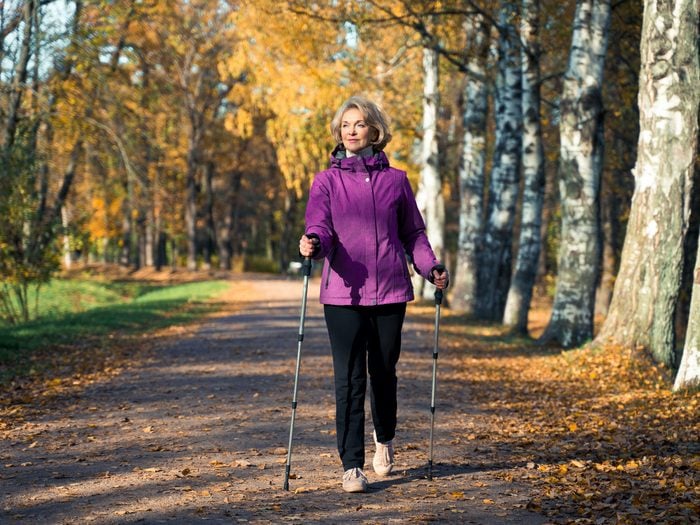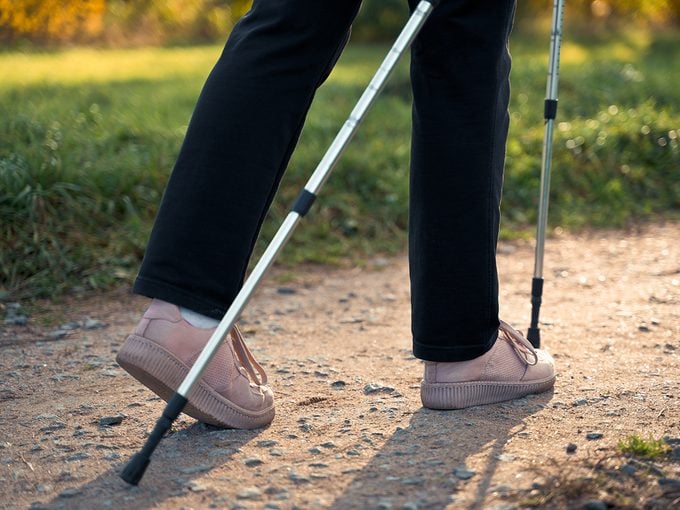Nordic Walking Wasn’t Easy to Learn—But Now I Love It

Nordic walking increases your heart rate and uses more muscles, making it a more full-body workout compared to walking without poles.
I’m a walker, logging an average of 9,000 steps a day several times a week around my Toronto neighbourhood. One of walking’s great charms for me is that you don’t need equipment. But on recent trips to Copenhagen and Stockholm, I noticed tall, fit Scandinavians striding along on city streets with poles, as if they were cross-country skiing without any snow. It was a revelation to learn that the addition of the poles makes it a more vigorous, full-body exercise than simply walking—and, as a 76-year-old looking to stay healthy while enjoying the outdoors, I decided to give a try.
There’s plenty of help online for the novice Nordic walker: stand tall, swing your arms out as if to shake hands and plant your poles with vigour. Then there’s the little matter of the glove-like strap on the pole. This allows the walker to grip the pole when thrusting forward and then relax that hand as the other hand pushes forward—a feat of coordination that builds stronger muscles.

Benefits of Nordic Walking
For a warm-up, I started in the wimpiest way imaginable: Nordic walking down the hall that extends from my front door to the deck. In case you’re tempted to sneer, that measures 19 good strides and it wasn’t easy. Back and forth down the hall, as I struggled to propel the right arm out while the left leg stepped—all while gripping and releasing properly—I was reminded of the poem about the centipede who went all to pieces when asked how she walked. Coordinating the movements wasn’t my only problem. As someone who can walk eight kilometres briskly without apparently raising my heart rate, the novel use of my arms and upper body was surprisingly strenuous. After half an hour, my heart was pounding and I was sweating, but I still wasn’t much good.
I pressed on, because there’s no arguing with the proven benefits of nordic walking. Nordic walkers’ upper-body exercise increases their heart rate significantly more than walking without poles. There’s up to 23 percent more oxygen delivered to the tissues. And according to Boston cardiologist Dr. Aaron Baggish, with poles “you’re engaging 80 to 90 percent of your muscles, as opposed to 50 percent, providing a substantial calorie-burning benefit.”
Cross-country skiers in Finland were early practitioners of the sport as a way of training off-season. In the early 1990s, it was adopted in North America as a rehabilitation tool. Peter Burrill, head of the Nordic Pole Walking program at InsideOut Physiotherapy in Toronto, says he’s seen the exercise speed up the post-surgical recovery of patients with new hips and knees. It also helps people with Parkinson’s: “We put poles in their hands and it’s amazing because they start walking with real rhythm.”
Meanwhile, out on the winding path around the cemetery near my house, I was still advancing three steps and falling back two. But after a few more clumsy days of being convinced I would never master the technique, suddenly everything clicked. Not only was I able to coordinate the movements, I was happily aware that my heart, arms and core were getting a workout.
Thinking back on those confident Nordic walkers I saw across the ocean, I wish I could report that participating in the sport for 45 minutes a few times a week has made me tall and blonde—but something even better has happened. I found exercise that adds an upper-body, aerobic component to my love of walking and it’s one I expect to enjoy for years to come.
Now that you know the benefits of Nordic walking, find out what happens when you start walking 10,000 steps a day.






